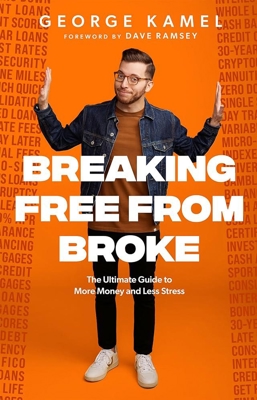Book Review for Breaking Free from Broke: Transform Your Financial Future with George Kamel

In a world where financial stress dominates conversations around dinner tables and workplace water coolers, George Kamel’s "Breaking Free from Broke" arrives as a beacon of hope and practicality. This book is not just another financial guide; it’s a transformative tool designed to revolutionize your relationship with money and set you on a path to financial freedom.
If you've ever walking through Dave Ramsey's baby steps or his Financial Peace University, this content will not be new, however, George does a great job of mixing humor and entertainment throughout.
Why "Breaking Free from Broke" Stands Out
From the get-go, Kamel brings a refreshing, no-nonsense approach to personal finance. He understands the real-world pressures and challenges that many face, and he expertly dismantles the myths that often lead to financial peril. The book is rich with actionable advice, leveraging Kamel's years of experience as a financial coach and personal finance expert.
1. Practical Strategies for Real People
A significant strength of "Breaking Free from Broke" lies in its relatability. Kamel doesn’t rely on highfalutin financial jargon or abstract theories. Instead, he presents clear, concise, and practical strategies that anyone can adopt. Whether you’re struggling to pay off debt, trying to save for a significant purchase, or planning for retirement, Kamel provides tailored advice that applies to your unique circumstances.
2. A Comprehensive Roadmap
The book offers a step-by-step roadmap to achieving financial stability and independence. Kamel begins by addressing the psychological barriers to financial wellness, enabling readers to shift their mindset and set realistic goals. From there, he delves into tactical topics such as budgeting, investing, and building an emergency fund. Each chapter builds on the last, creating a cohesive journey toward financial health.
3. Real-Life Success Stories
One of the most inspiring aspects of "Breaking Free from Broke" is its inclusion of real-life success stories. These narratives bring the principles Kamel discusses to life, showing readers that financial transformation is not only possible but achievable. These case studies also provide practical insights and proven techniques from individuals who have successfully navigated their financial struggles.
4. Interactive Tools and Resources
Kamel goes beyond traditional book formats by including interactive tools and resources. Readers have access to downloadable worksheets, budgeting templates, and financial calculators, enabling them to put the book’s lessons into immediate practice. These tools help bridge the gap between theory and action, making it easier for readers to implement Kamel’s advice in their daily lives.
5. Long-Term Vision and Sustainability
What sets "Breaking Free from Broke" apart is its emphasis on sustainability. Kamel doesn’t advocate for quick fixes or temporary solutions. Instead, he encourages readers to adopt long-term habits that will ensure enduring financial health. This forward-thinking approach helps readers not only to get out of debt but to stay out and build wealth over time.
Why Businesses Should Pay Attention
From an organizational standpoint, promoting financial literacy among employees can have a direct impact on productivity and morale. Financial stress is a leading cause of anxiety and distraction in the workplace. By encouraging staff to read "Breaking Free from Broke" and even potentially incorporating its principles into corporate wellness programs, businesses can foster a more engaged and focused workforce. Offering financial wellness training based on Kamel’s book can be a powerful benefit that enhances overall job satisfaction and retention.
Chapter Summaries
These are my personal summaries after reading the book. They are more my main takeaways than George's verbatim thoughts. I will be looking at these points in the future to fire myself back up.
Chapter 1: Chained to the System
There is a machine set in motion that is highly sophisticated and it works against us. If we don't pay attention, we can easily get caught up and go with the flow. This flow takes our money without us noticing. We must take the time to stand up, look around and vow to not be normal. Normal is broke with lots of debt to multiple sources.
Chapter 2: Credit Scores
Credit scores are how most companies know if we are good consumers. The higher the number, the better we are at paying back debt. However, George tells us that the goal should be to not have a credit score. This means that we don't go into debt since debt is the only way credit scores rate us. Without debt, it means we are paying for things with money we actually have. Don't use credit.
Chapter 3: Credit Cards
Credit cards make us spend more. It's easy and these companies spend truck loads of money enticing us to use their cards. Even if we pay off our cards continually (which most people don't), we still spend more than we would with cash. The “perks” are not worth the tradeoff. Use debit cards exclusively.
Chapter 4: Student Loans
Student Loans burden young people with a massive amount of debt to start off their adult life. Again, the machine is setup to make money for themselves. Also, many students go to schools for the “experience” rather than an education. Many schools offer luxury to entice students and charge accordingly. Some points to consider are:
- If going to a university, make sure you get a degree that you can actually use to support yourself. (no underwater basket weaving for $60k/year).
- Go to a community college for your gen-eds.
- Community college is like a tenth the price of university.
- Trades are highly needed and have a huge employment gap currently.
Chapter 5: Car Loans
Don't buy a car on credit. You end up paying thousands more and those thousands invested in mutual funds will eventually be a mountain of money for your. Also, never buy new, cars lose their value by 10% as you drive it off the lot, 25% after 1 year, 35% after 2 years, 55% after 4 years, etc. They cost too much to be such a poor investment.
Chapter 6: Mortgages
Because of the size of the investment, mortgages are the only thing that borrowing money is okay. But only if it's on a 15-year (or less) fixed mortgage. Any other type is a scheme and will end up costing you more money.
Chapter 7: Investing Traps
There are a ton of types of investing. Many companies will have good sales pitches to say why they have a great deal. However, the best bet by far is to invest in mutual funds with long track records of earning of 10%+/year.
Chapter 8: Marketing & Consumerism
Here is the machine. They are smart, organized and want to turn your money into theirs. The average person sees thousands of ads per day…thanks smart-phones :(. Only buy what you have budgeted for. Never impulse buy. If you need something today, think about it for a day or two to see if it's still important later.
Chapter 9: Breaking Free From the System
Time to get ticked off at the system. Living in the system means you're getting ripped off. Stop the madness.
Chapter 10: Budgeting is Freedom
A budget is the key to winning with money. This chapter is the main one in the book. This is important is personal finances as well as business finances. Make all your money work for you. Have a plan for every penny. No excuses!
Chapter 11: Spending is Self-Control
Only spend according to your budget. Self-control sucks, but it reaps many more benefits in the long-term. Don't complain, just make the plan (budget) and do it.
Chapter 12: Margin is Breathing Room
Margin is having extra money. Odds are, we have subscriptions we're not using, we're spending without a budget, we're paying minimums on all debts. Once applying a budget, most people can free up $500-1000 a month if they adhere to a budget. Once you get your debts paid off, you'll have an emergency fund for things that come up.
Chapter 13: Debt is a Thief
Paying back debts means you're paying a lot of money in interest. If you didn't have those payments, you could invest in mutual funds where you get the interest. Also, compound interest is the secret in becoming a millionaire.
Chapter 14: Savings Is Peace
Imagine not having any debts, knowing where all your money is going and having a healthy emergency fund. You won't have much to worry about financially if that was the case. Invest 15% of your income.
Chapter 15: Wealth Is Patience
Compound interest will make you a millionaire, but it takes awhile. The more and earlier you are able to invest in mutual funds, the more you'll have later in life.
Chapter 16: Generosity is Joy
Outrageous giving will make you happier than hoarding money ever will. This is the ultimate goal. Make a ton, so you can give a ton.
Conclusion
"Breaking Free from Broke" by George Kamel is more than just a book; it’s a movement towards financial empowerment. For individuals seeking to reclaim control over their finances and for businesses invested in the well-being of their employees, it offers a clear, actionable plan towards a healthier, wealthier future. For me, this was a refresher and lit a fire under me to get back to focusing on my finances and planning for the future.

